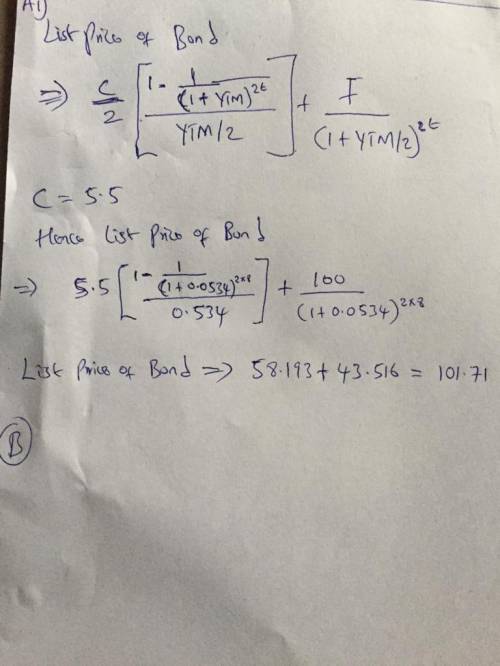
Business, 05.11.2020 17:00 marxusalexander6552
Consider a bond with a settlement date of February 22, 2010, and a maturity date of March 15, 2018. The coupon rate is 5.5%.
If the yield to maturity of the bond is 5.34% (bond equivalent yield, semiannual compounding), what is the list price of the bond on the settlement date?
What is the accrued interest on the bond? What is the invoice price of the bond?
Now suppose the bond in the previous question is selling for 102. What is the bond’s
yield to maturity?
What would the yield to maturity be at a price of 102 if the bond paid
its coupons only once per year?

Answers: 2


Other questions on the subject: Business

Business, 21.06.2019 21:30, annethelusma25
Which of these things did galileo not do? a. stop publishing his scientific work after being convicted of heresy b. invent the concept of acceleration c. experiment with rolling balls down ramps of increasing steepness to test how objects would fall d. argue that earth moves around the sun e. make up a thought experiment that indicated that objects would fall at the same rate
Answers: 3

Business, 22.06.2019 00:40, mmsomefood85
Gdonald was unhappy that his company did not provide good transport facilities. he found it very strenuous to drive to work on his own, and this eventually led to job dissatisfaction. hence, he recommended ways to solve this problem. according to the evln model, this information suggests that donald's main reaction to job dissatisfaction was:
Answers: 3

Business, 22.06.2019 21:00, diablo871
Frost corporation incurred the following transactions during its first year of operations. (assume all transactions involve cash.) 1) acquired $1,900 of capital from the owners. 2) purchased $435 of direct raw materials. 3) used $290 of these direct raw materials in the production process. 4) paid production workers $490 cash. 5) paid $290 for manufacturing overhead (applied and actual overhead are the same). 6) started and completed 250 units of inventory. 7) sold 140 units at a price of $6 each. 8) paid $130 for selling and administrative expenses. the amount of raw material inventory on the balance sheet at the end of the accounting period would be:
Answers: 3

Business, 22.06.2019 21:10, leo4687
Match the terms with their correct definition. terms: 1. accounts receivable 2. other receivables 3 debtor 4. notes receivable 5. maturity date 6. creditor definitions: a. the party to a credit transaction who takes on an obligation/payable. b. the party who receives a receivable and will collect cash in the future. c. a written promise to pay a specified amount of money at a particular future date. d. the date when the note receivable is due. e. a miscellaneous category that includes any other type of receivable where there is a right to receive cash in the future. f. the right to receive cash in the future from customers for goods sold or for services performed.
Answers: 1
You know the right answer?
Consider a bond with a settlement date of February 22, 2010, and a maturity date of March 15, 2018....
Questions in other subjects:


Physics, 29.09.2020 05:01

Mathematics, 29.09.2020 05:01


Biology, 29.09.2020 05:01



Mathematics, 29.09.2020 05:01






